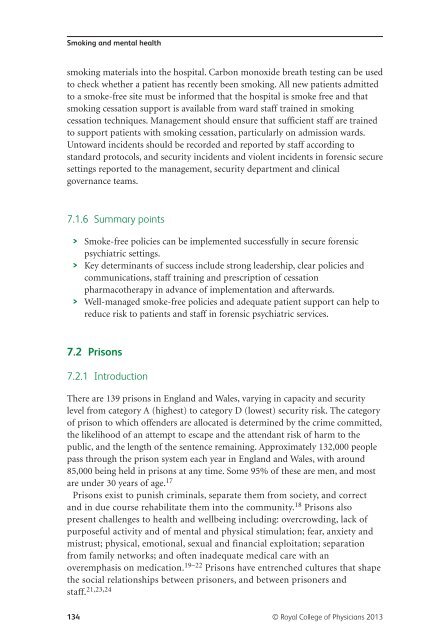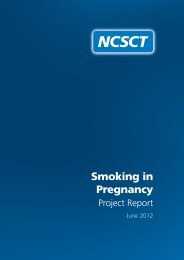Smoking and mental health - NCSCT
Smoking and mental health - NCSCT
Smoking and mental health - NCSCT
Create successful ePaper yourself
Turn your PDF publications into a flip-book with our unique Google optimized e-Paper software.
<strong>Smoking</strong> <strong>and</strong> <strong>mental</strong> <strong>health</strong><br />
smoking materials into the hospital. Carbon monoxide breath testing can be used<br />
to check whether a patient has recently been smoking. All new patients admitted<br />
to a smoke-free site must be informed that the hospital is smoke free <strong>and</strong> that<br />
smoking cessation support is available from ward staff trained in smoking<br />
cessation techniques. Management should ensure that sufficient staff are trained<br />
to support patients with smoking cessation, particularly on admission wards.<br />
Untoward incidents should be recorded <strong>and</strong> reported by staff according to<br />
st<strong>and</strong>ard protocols, <strong>and</strong> security incidents <strong>and</strong> violent incidents in forensic secure<br />
settings reported to the management, security department <strong>and</strong> clinical<br />
governance teams.<br />
7.1.6 Summary points<br />
> Smoke-free policies can be implemented successfully in secure forensic<br />
psychiatric settings.<br />
> Key determinants of success include strong leadership, clear policies <strong>and</strong><br />
communications, staff training <strong>and</strong> prescription of cessation<br />
pharmacotherapy in advance of implementation <strong>and</strong> afterwards.<br />
> Well-managed smoke-free policies <strong>and</strong> adequate patient support can help to<br />
reduce risk to patients <strong>and</strong> staff in forensic psychiatric services.<br />
7.2 Prisons<br />
7.2.1 Introduction<br />
There are 139 prisons in Engl<strong>and</strong> <strong>and</strong> Wales, varying in capacity <strong>and</strong> security<br />
level from category A (highest) to category D (lowest) security risk. The category<br />
of prison to which offenders are allocated is determined by the crime committed,<br />
the likelihood of an attempt to escape <strong>and</strong> the attendant risk of harm to the<br />
public, <strong>and</strong> the length of the sentence remaining. Approximately 132,000 people<br />
pass through the prison system each year in Engl<strong>and</strong> <strong>and</strong> Wales, with around<br />
85,000 being held in prisons at any time. Some 95% of these are men, <strong>and</strong> most<br />
are under 30 years of age. 17<br />
Prisons exist to punish criminals, separate them from society, <strong>and</strong> correct<br />
<strong>and</strong> in due course rehabilitate them into the community. 18 Prisons also<br />
present challenges to <strong>health</strong> <strong>and</strong> wellbeing including: overcrowding, lack of<br />
purposeful activity <strong>and</strong> of <strong>mental</strong> <strong>and</strong> physical stimulation; fear, anxiety <strong>and</strong><br />
mistrust; physical, emotional, sexual <strong>and</strong> financial exploitation; separation<br />
from family networks; <strong>and</strong> often inadequate medical care with an<br />
overemphasis on medication. 19–22 Prisons have entrenched cultures that shape<br />
the social relationships between prisoners, <strong>and</strong> between prisoners <strong>and</strong><br />
staff. 21,23,24<br />
134 © Royal College of Physicians 2013














